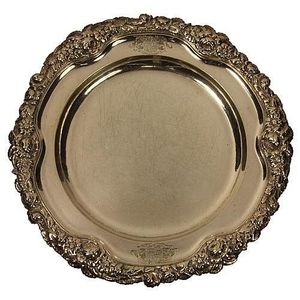Antique 14ct Gold Fob Watch for Restoration
You must be a subscriber, and be logged in to view price and dealer details.
Subscribe Now to view actual auction price for this item
When you subscribe, you have the option of setting the currency in which to display prices to $Au, $US, $NZ or Stg.
- Back Plate - On many types of clocks, the movement operates between two plates, usually made of brass, one at the back, and the other at the front, which forms a mount for the dial.
On English bracket, mantle and table clocks the backplate was often visible through a glass door or panel from the late 17th century, and could be profusely engraved with scrolling decorations, flowers, foliage, birds, and figures. The engraving could also include the maker?s name.
The amount of engraving reduced and became simpler as the 18th century progressed, and by 1800, had been reduced to a border, often with the maker's name in the centre. By the early 1800s all decoration had ceased, and only the maker's name was added, and by the Victorian era, most bracket, mantle and table clocks had no engraving. - Rolled Gold - A type of gold plating devloped in the early 19th century, similar to Sheffield plating of silver, where the the gold is fused under pressure and heat to a base metal, usually brass, and then rolled into sheets of the required thickness.
The thickness of the gold plate can vary. In Britain the thickness of the gold is measured in microns. A micron is one-thousandth of a millimetre and 20 microns of gold is considered good quality. In the USA a differnt method is used that takes account of the total weight of the object.
Also, the purity of the gold, measured in carats can vary, with 24 carat being the purest. The gold in most rolled gold objects will be between 9 and 14 carats.
There are other chemical and electroplating methods of applying gold plate to a base metal, but rolled gold is considered a superior plate to a "gold plated" object.
Depending on the country and date of manufacture, the object may be stamped "Rolled Gold" or similar, but if there is any doubt as to whether an object is solid gold, or some type of gold plating, it is preferable to have it tested by a jeweller.
This item has been included into following indexes:
Visually similar items

Eleven vintage silver twist bangles, not marked but tested as silver

English hallmarked sterling silver George III set of twelve plates with embossing and amorials. London, 1819, maker Benjamin Smith III diameter 27 cm weight 9550g

Montgomery Bros Sterling silver bon bon dish, hallmarked to base, with pierced decoration, 130grams, W21 cm approx

A rare Worcester Dr Wall porcelain 'Dalhousie' dessert plate, circa 1770, with gilt enriched cobalt blue border, the fluted body painted with interspersed butterflies and fruit, centrally painted with pastoral and stream scene, crescent mark, 18 cm diamete
